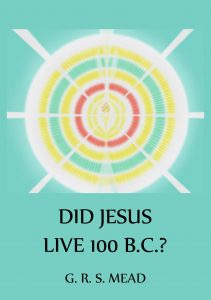Did Jesus Live 100 B.C.? – G. R. S. Mead
The answer to the title question of this book, which the author answers as probably affirmative, cannot very well be established, but the natural problems which the author treats in the successive chapters are of great interest and betray a wide reading and a thorough knowledge of the Talmud and kindred sources that have reference to the legends connected with the stories of Jesus and the origin of Christianity. In several sections, especially with regard to the quotations from Livy, Pliny and Suetonius, the author shows good judgment. His reports concerning the prosecution of the Talmud are told in a very popular way and will not so easily be found elsewhere in such accessible form. The stories of Yeschu (Jeschu), the Mary stories of the Talmud, the Jesus stories and the Toldoth Jeschu, are rarely found except in scattering legends of Jewish literature. Though the author is not always reliable and is sometimes bold in his conclusions, the book is stimulating and interesting
Format: Paperback.
Did Jesus Live 100 B.C.?.
ISBN: 9783849672263.
Available at amazon.com and other venues
G. R. S. Mead and the Theosophical Society (from wikipedia.com)
While still at Cambridge University Mead read Esoteric Buddhism (1883) by Alfred Percy Sinnett. This comprehensive theosophical account of the Eastern religion prompted Mead to contact two theosophists in London named Bertam Keightly and Mohini Chatterji, which eventually led him to join Helena Petrovna Blavatsky’s Theosophical Society in 1884.
In 1889 he abandoned his teaching profession to become Blavatsky’s private secretary, and also became a joint-secretary of the Esoteric Section (E.S.) of the Theosophical Society, reserved for those deemed more advanced.
Mead received Blavatsky’s Six Esoteric Instructions and other teachings at 22 meetings headed by Blavatsky which were only attended by the Inner Group of the Theosophical Society. It was because of the intimacy Mead felt with the Inner Group that he married Laura Cooper in 1899.
Contributing intellectually to the Theosophical Society, at first most interested in Eastern religions, he quickly became more and more attracted to Western esotericism in religion and philosophy, particularly Neoplatonism, Gnosticism, and Hermeticism, although his scholarship and publications continued to engage with Eastern religion. Making many contributions to the Theosophical Society’s Lucifer as joint editor, he eventually became the sole editor of The Theosophical Review in 1907 (as Lucifer was renamed in 1897).
As of February 1909 Mead and some 700 members of the Theosophical Society’s British Section resigned in protest at Annie Besant’s reinstatement of Charles Webster Leadbeater to membership in the society. Leadbeater had been a prominent member of the Theosophical Society until he was accused in 1906 of teaching masturbation to the sons of some American Theosophists under the guise of occult training. While this prompted Mead’s resignation, his frustration at the dogmatism of the Theosophical Society may also have been a major contributor to his break after 25 years.
(The text of the last section was taken from a Wikipedia entry and is available under the the Creative Commons Attribution-ShareAlike License.)
Publisher’s Note: This book is printed and distributed by Createspace a DBA of On-Demand Publishing LLC and is typically not available anywhere else than in stores owned and operated by Amazon or Createspace.

